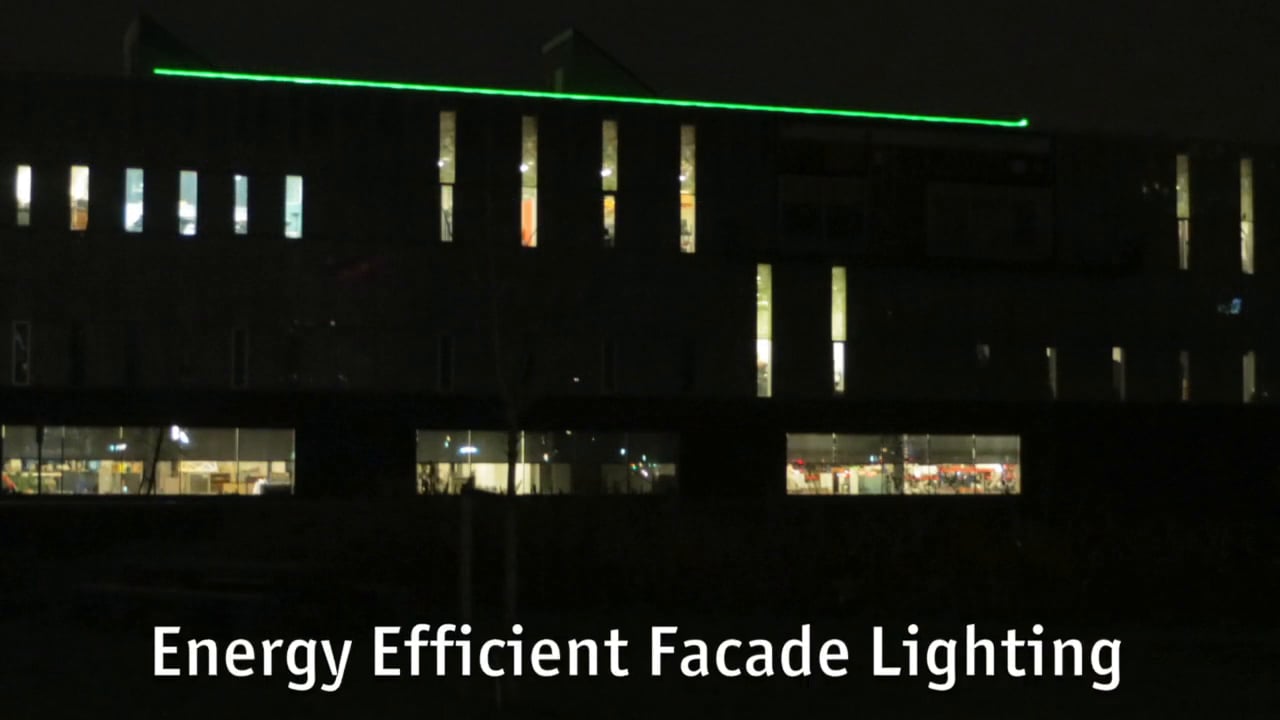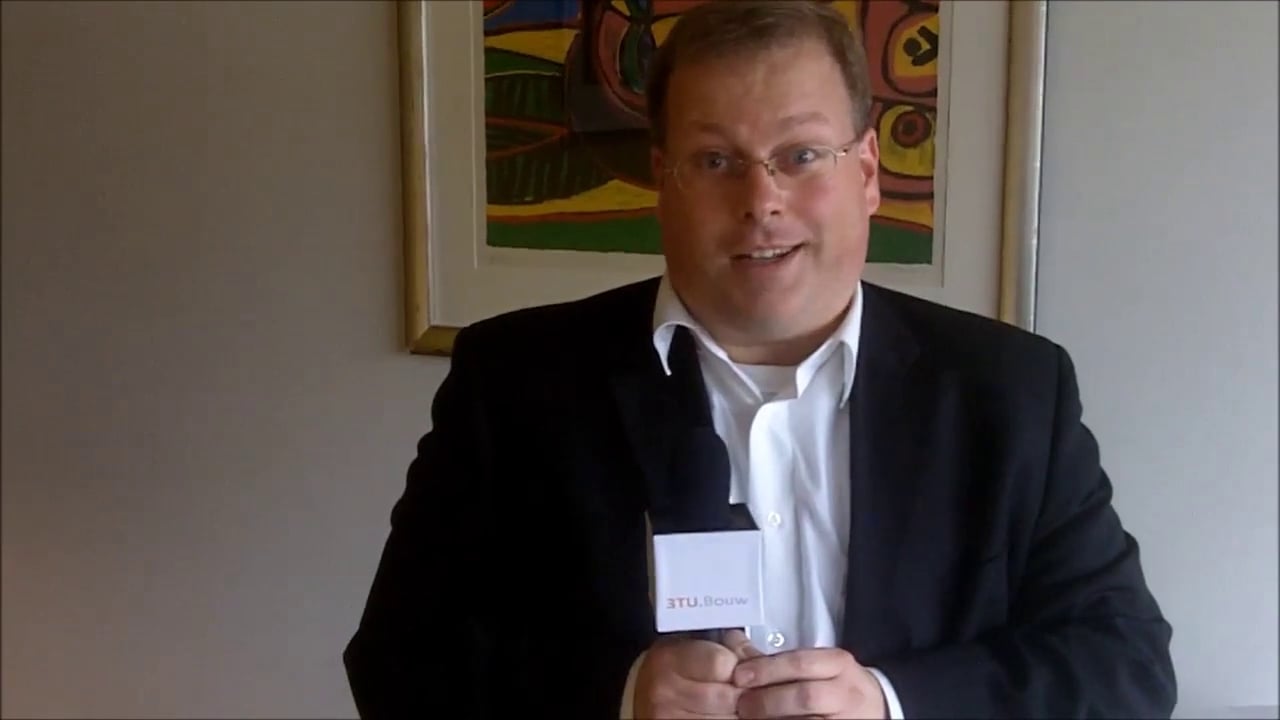(Image of an 80 m fibre optic cable, © BL Lighting, used with permission)
The project set out to proof that a conventional optical fibre lighting system for highlighting the structure of a façade can be operated more energy-efficiently through the substitution of the projector using a metal halide reflector lamp by a laser. This is investigated by looking into the photometric assessment of such systems as well as the electric power draw during operation. In preparation for a potential exterior demonstration installation, an additional focal point of the research was the design and testing of a weatherproof case that provides protection to the laser and the ballast. The final stage brought the different aspects of the research together and resulted in a temporary experimental setup (pilot installation) in order to showcase the validity of this novel approach.
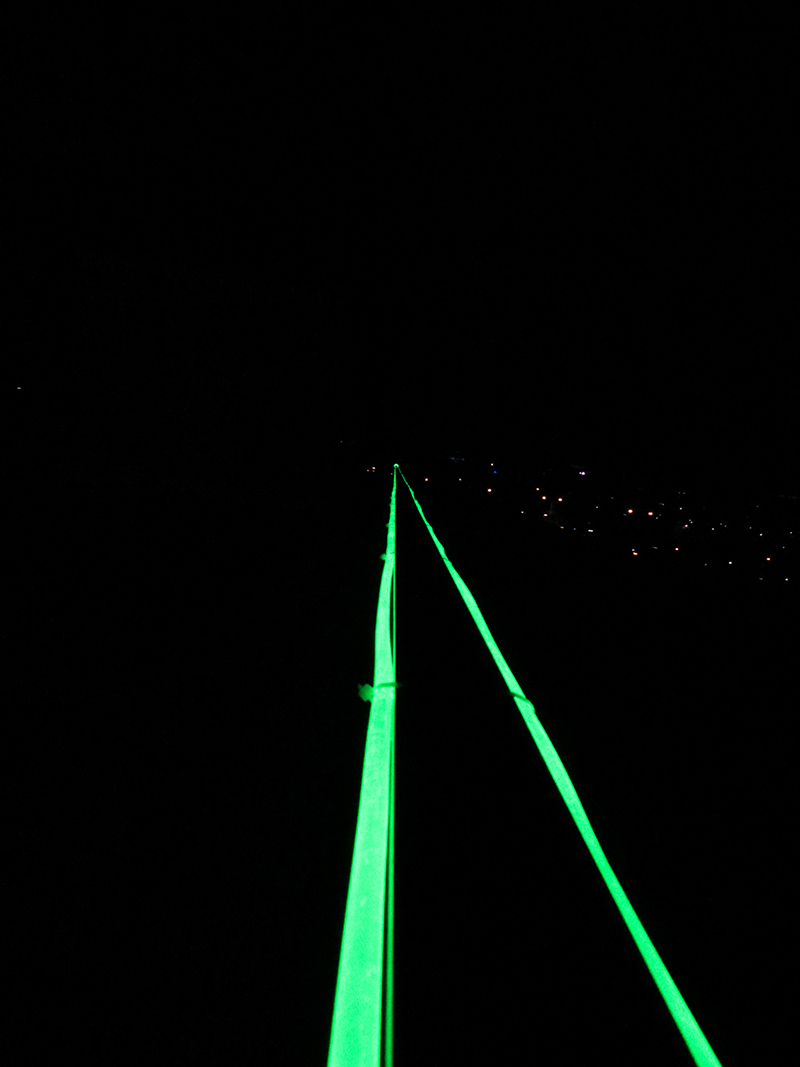
Throughout the project there was active communication between the partners. Meetings took place in Eindhoven, Delft, and Den Haag. At the TU/e two students were recruited to participate in the research project, and at both universities the possibilities for demonstration projects were explored. During the discussions, ideas for details on the overall approach and the setup were developed. The brainstorming continued with the students at their regular project update meetings. They developed the research questions and mapped out their approach in a measurement plan. The student project results were presented at an intermediate workshop and to the project partners.
The weather proofing of the box is being tested for its performance under various exterior conditions, using a climate chamber, by measuring: the interior temperature in the box, the humidity in the box, and the protection against simulated precipitation (snowfall and rain). After energy performance determination, the photometric assessment focused on two main sets of measurements; illuminance measurements indicating the relative luminous flux coupled out from the fibre and luminance measurements under different observation angles.The illuminance measurements were carried out along the fibre as well as around the fibre. This produces an indication over the attenuation of the extracted light and also the uniformity of the light extraction. The illuminance at a defined and constant distance is a measure for the relative luminous flux leaving the fibre. In addition to that, the luminance from different observing directions was recorded to evaluate the expected brightness perception. The photometric assessment was done for three laser types: red, green and blue.
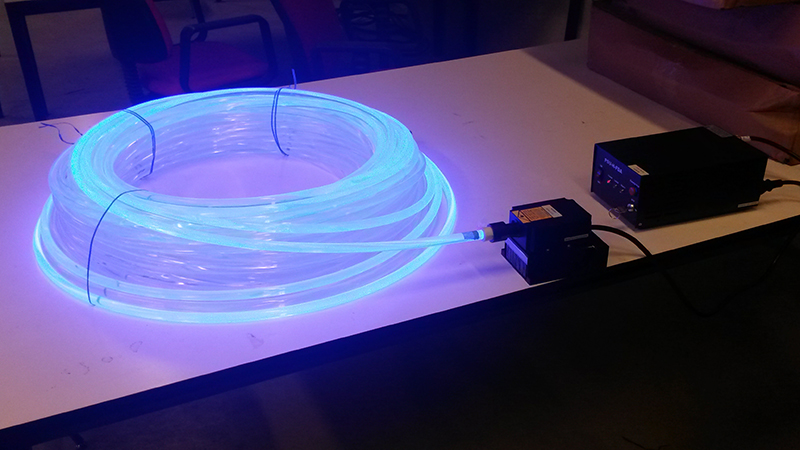
Power consumption measurements
A BL Innovative Lighting fiber is connected to a metal halide (MH) lamp of about 190 W; either on one or two sides of the fiber. Currently, the maximum commercially available length of this fiber is 80 meters, and would require at least four MH lamps to light the full fiber length, with a total energy consumption of 764 W. However, if a MH lamp were to illuminate the fiber from a single end the maximum lenght would be about 13 meters (including visible light loss). With the laser installation, the power consumption over the first 15 minutes after starting the laser was recorded. The results for the three laser types tested are showing a stabilized power draw for the red, green, and blue laser of 59 W, 71 W, and 54 W respectively. The difference in power consumption of the least efficient laser system (2*71 W) compared to a system lit with MH lamps over a comparative fiber length of 80 meters would be five times lower (142 W vs. 764 W), resulting in a savings of approximately 80%.
Photometric measurements
The illuminance was measured at a constant distance from the fibre. This was achieved through the use of a device that was designed and built for this purpose. It can wrap around the fibre and holds the photo element in place. The measurement distance was approximately 1 cm to get the maximum dynamic range. The illuminance measurements are an indicator for the relative luminous flux leaving the fibre. Luminance measurements have been taken under different observation angles around a measurement point. The results give an indication on the brightness perception when viewing the installation from different positions. As a rule of thumb, differences in brightness occur when the luminance difference is approximately one order of magnitude.
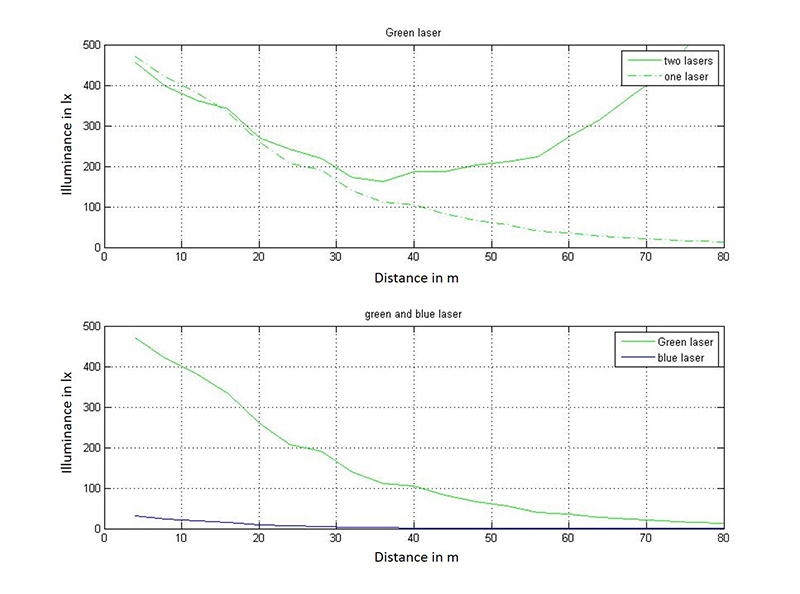
Measurement along the fibre
The measurements along the fibre show that the relative luminous flux coupled out is attenuating over the length of the fibre. The data for a system fed by one laser shows that the relative luminous flux drops by one order of magnitude at a distance of approximately 55 m. A fibre system that is fed by two lasers shows the expected symmetric behaviour. The minimum occurs in the middle of the fibre. There the relative luminous flux is approximately 40% of its initial value The measurements for a one-laser system can be mirrored to calculate the relative luminous flux along the fibre. The calculations results match the measurements very closely.
Measurement around the fibre
As a measure for the uniformity in all directions, the illuminance was measured on the four spots around the fibre every 8 m along the fibre (0, 90°, 180° and 270°). The most noteworthy non-uniform light extraction can be observed at the beginning of the fibre. This is likely caused by slight misalignments of the laser axis and the axis of the fibre that are believed to cause non-uniform light losses at the beginning
Luminance measurements
The luminance measurements were taken for two situations: the fibre being fed by one laser and the fibre being fed by two lasers. As expected, the luminance drops along the length in a similar manner as the relative luminous flux. This effect is reduced in a system fed by two lasers. The luminance is relatively similar for all viewing angles (ranging from 30° to 150° with 90° indicating the surface normal). For a two-laser setup, the minimum luminance drops from approximately 200 cd/m2 to approximately 40 cd/m2. This drop is not leading to a perception of brightness difference according to the rule of thumb mentioned earlier. The laboratory measurements indicate that no visible difference along the fibre system would be noticed.
Temperature dependence
According to the manufacturer’s data sheets, the laser systems consisting of a power supply box and the laser module itself need to be operated in ambient temperatures between 10°C and 35°C. A few experiments investigated the influence of the ambient temperature on the light output. The first measurement series looked at the system’s performance when ramping up the ambient tem- perature slightly beyond the upper boundary of the recommended temperature range and letting it cool down afterwards. The illuminance measurements indicated the impact on the overall light output. The ambient temperature in the upper part of the recommended temperature range has no significant impact on the light output.
Normal operation within an enclosure can often lead to a fluctuating ambient temperature. Such a temperature profile was simulated in the laboratory and also leads to no significant changes in light output. After the lighting system is stabilized, the illuminance values ranged between 55 lx and 56.5 lx which corresponds to a maximum variation of 1.1%.
Pilot installation
A working prototype of the laser/fibre system has been demonstrated on the roof of the Vertigo building on the TU/e campus in December 2014. The 80 m long fibre was installed along the inside and outside of a roof rail resulting in a 40 m long light installation that could be seen from the building as well as from the ground.
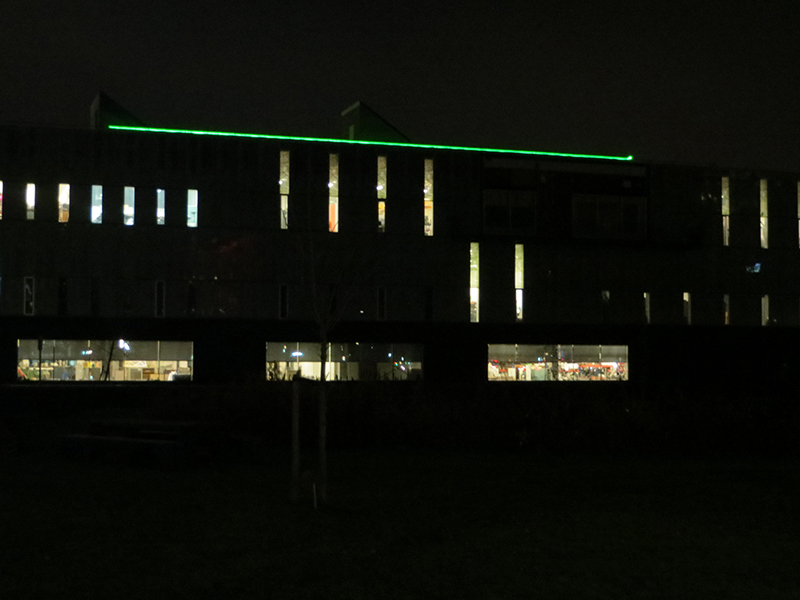
80% Reduction of energy
The results of this project show that the fibre system fed by lasers is a feasible technology to highlight facades of buildings. The photometric data shows that the system can be operated in such a way that no noticeable brightness differences can be sensed along the fibre. The energy consumption of the lasers are much lower compared to the conventional solution, resulting in a savings of at least 80%. This means that the investigated system is an adequate energy-efficient alternative to conventional fibre lighting systems.
The investigated system is an adequate energy-efficient alternative to conventional fibre lighting systems, resulting in savings of at least 80%.
Recommendations for the future include following technology developments to see if such laser systems can be reduced in size for a better integration into the overall system. The current laser system was not developed for a fibre lighting system but rather for measurements/experiments on optical benches. Some of the features and requirements that are currently part of the product may not be required for usage in combination with fibre optics. This can lead to a reduced size and cost for a laser system that would positively impact the economics of real installations.
Project Team:
Eindhoven University of Technology
dr. Myriam Aries
prof. Dr.-Ing. habil. Alexander Rosemann
Wies Westerhout
Mitchel Hoos
Delft University of Technology
assoc. prof. dr. Truus Hordijk
Lighting designer
ing. Rienk Visser
BL Innovative Lighting - Vancouver
Betty Lou Pacey




